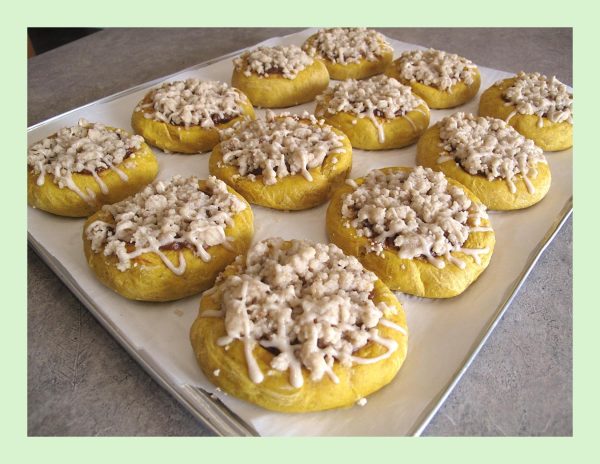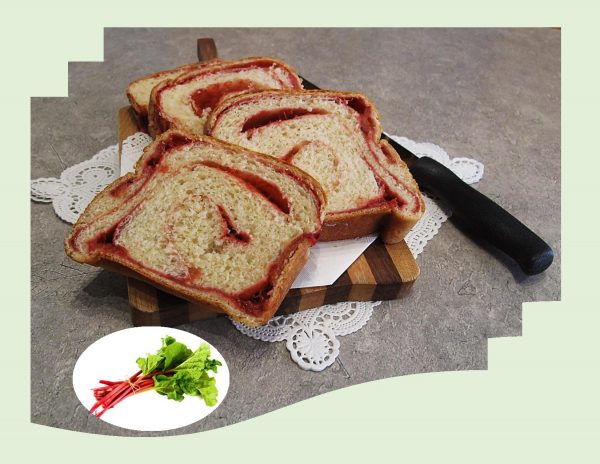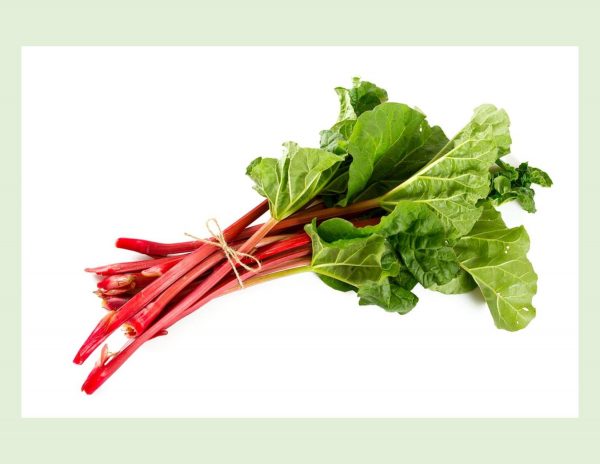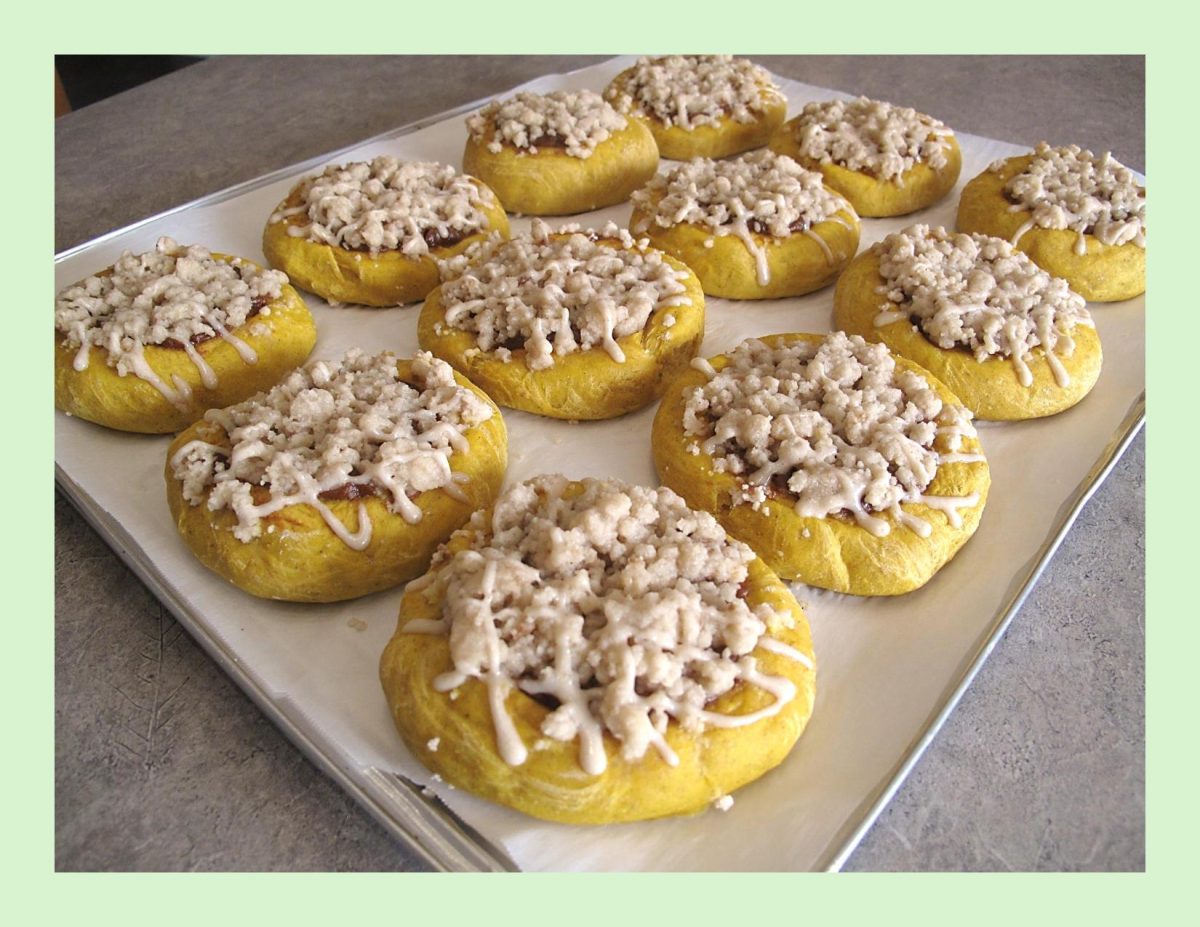
Nothing tastes more like fall than fresh baked pumpkin goods. I love just about anything with pumpkin in it. It definitely wasn’t always that way but it’s amazing how your taste buds change as time passes.
My original thoughts were to make some German pumpkin plachinda. It was one of those wonderful things my mother used to make that got pushed into the back of my memory.
It seems most recipes you find on the internet make plachinda as individual pastry turnovers with a pumpkin filling. I think I recall my mother making it in a rectangle casserole dish with the pastry on the bottom and up the sides and the filling showing.
I decided to do some ‘recipe development’ and try making some German streuseltaler and top it with a sweet pumpkin (plachinda) filling.
Streuseltaler was inspired by the round shape of the taler, a silver coin used throughout Europe for almost four hundred years. Its name lives on in the currency called dollar.
Taler is a German word for coin, so the name of the dessert literally translates to streusel coin. Basically, a free form tart made with a yeast dough topped with a huge amount of streusel, sometimes filled with custard and often with a sugar glaze.
A traditional German streusel (streusel meaning something ‘strewn or scattered’ in German) bakes up into shortbread balls. It makes a crunchy, cookie-like top but is soft on the bottom where it meets the bread or fruit compote.
Streusel was first popularized in Germany. In its simplest form, it consists of flour, sugar and butter but gets even better with the addition of oatmeal, cinnamon and nuts …. just my opinion of course!
In the history of cooking, one could find recipes that have constantly changed and could be seen as a connecting link between modern times and our past. I guess this is my contribution to the evolution of plachinda.
For all of you who love pumpkin, here’s a treat you don’t want to miss!
Print Recipe
Pumpkin Streuseltaler
Votes: 1
Rating: 5
You:
Rate this recipe!
|
|
Votes: 1
Rating: 5
You:
Rate this recipe!
|
Instructions
Dough
In a small bowl, add yeast, lukewarm water & 1 tsp sugar. Allow to sit about 10 minutes until frothy.
In a large bowl, combine yeast mixture, butter, salt, cinnamon, eggs & pumpkin puree. Mix well. Add flour, one cup at a time, until well combined. Knead dough for about 8-10 minutes or until smooth & soft. Place dough in a greased bowl, cover with a tea towel & allow to rise for about 1 hour or until double in size.
Filling
In a small dish, combine the filling ingredients, set aside.
Streusel Topping
In a small bowl, combine flour, sugar, vanilla, cinnamon & salt. With a pastry blender, cut in butter until mixture resembles coarse crumbs. Set aside.
Assembly & Baking
Line a baking sheet with parchment paper. Place dough on a lightly floured work surface & divide into 12 pieces. Form each piece into a ball & allow it to rest for about 5 minutes.
Space out the balls on parchment lined baking sheet. With fingertips or the back of a Tbsp., press out center of each ball to about 4-inch diameter. Add about a Tbsp of pumpkin filling to each dough piece & spread leaving a border around the outside.
Divide streusel topping evenly between the pastries. Allow to rise for about 15-20 minutes.
-
Bake for about 10-12 minutes. Allow to cool completely on a wire rack. In the meantime, you can prepare the glaze.
Glaze
In a small dish, whisk powdered sugar & lemon juice to a thick glaze. When streuseltaler are cooled, drizzle with glaze.
Recipe Notes
- The picture at the bottom of the recipe is MY version of my mother's plachinda. I had posted it on a blog in October 2016. She used to serve this wonderful pastry when she made a white bean soup. At the time I thought it was an odd combination but it works! Another one of those 'taste of a memory' kind of comfort foods.

Rhubarb is the rebel of the vegetable world. It looks like celery, tastes like sour candy, its leaves are poisonous and unlike most spring and summer produce, its barely edible raw. With such a feisty personality, its no wonder some are intimidated to cook it.
More than any other fruit or vegetable, rhubarb to me is the sign of the changing season. It is the signal that summer is arriving in those ruby red or speckled green & pink stalks. I snap up what I can in the garden and when I see it at the supermarket. I take all I can and more, slicing and freezing the excess for rhubarb cravings that come in winter.
Year-round, I save rhubarb recipe ideas I hope to make once I get my hands on the first stalks of the season. No summer would be complete without cinnamon rhubarb bread …. still warm from the oven and the heavenly smell of cinnamon in the air!
Print Recipe
Cinnamon Roll Rhubarb Bread
Votes: 1
Rating: 5
You:
Rate this recipe!
|
|
Votes: 1
Rating: 5
You:
Rate this recipe!
|
Instructions
Rhubarb Filling
In a saucepan, combine all ingredients except vanilla & food color. Heat to medium high & stir occasionally until rhubarb begins to break down completely. Remove from heat, stir in vanilla & food coloring; allow to cool to room temperature.
Dough
In a small dish, combine yeast with lukewarm water & 1 teaspoon of the sugar. Allow to sit for a few minutes until frothy.
In a large bowl, slightly melt butter; cool a couple of minutes then whisk in egg. In another bowl, whisk together flour, salt & remaining sugar. Add yeast mixture to butter mixture, whisking together. Add flour mixture, combine then turn on a floured work surface & knead for about 5 minutes. Dough will be very soft but not sticky.
Lightly grease bowl, place dough ball in it & cover with a towel. Place in a draft-free place & allow to rise for about 20 minutes. Butter a 9 x 5-inch loaf pan; set aside
Turn the dough onto a lightly floured work surface & press down to deflate it. Fold in the two opposite sides to meet in the middle, then fold in the remaining two sides to meet, so that you've formed the dough into a square. Press down to flatten it slightly, then cover loosely and let stand for 10 minutes
With a floured rolling pin, rolling the dough to form a rectangle that's 12 by 22 inches. Make the corners as square as possible. If you're having trouble with the dough shrinking back, pause briefly before trying again.
Spread rhubarb/cinnamon filling over the dough, leaving a 1-inch border around the edges. Now fold the two long sides of the dough in one at a time, so that the meet each other in the middle. Pinch them together gently to seal the seam. Gently roll over the surface with a rolling pin to flatten the folded dough to about 7 by 25 inches.
Starting at the narrow end, roll up the dough, making a thick spiral. When you get to the end, brush a little egg wash on the loaf at the spot where the end will hit. Pinch the end a bit to seal it.
Carefully & gently place the roll, seam side-down in the buttered pan. The roll of dough should nearly fill it. Cover it loosely with plastic wrap & place in a warm, draft-free place to rise for about 25-30 minutes, until almost doubled & about 2 inches above the top of the pan. Meanwhile, adjust the oven racks so that you have one rack one-third up from the bottom of the oven.
-
Lightly brush remaining egg wash over loaf & bake for about 20 minutes. You may need to cover the top loosely with aluminum foil towards the end of baking to prevent over-browning. Bake until the loaf, when removed from the pan, sounds hollow when tapped with your fingertips. Cool on a rack.
Glaze
Make glaze by whisking together 2 Tbsp rhubarb filling, 1 cup powdered sugar, and enough lemon juice to make the glaze pourable (1-2 tbsp should do it). When bread has slightly cooled, drizzle with glaze if desired.
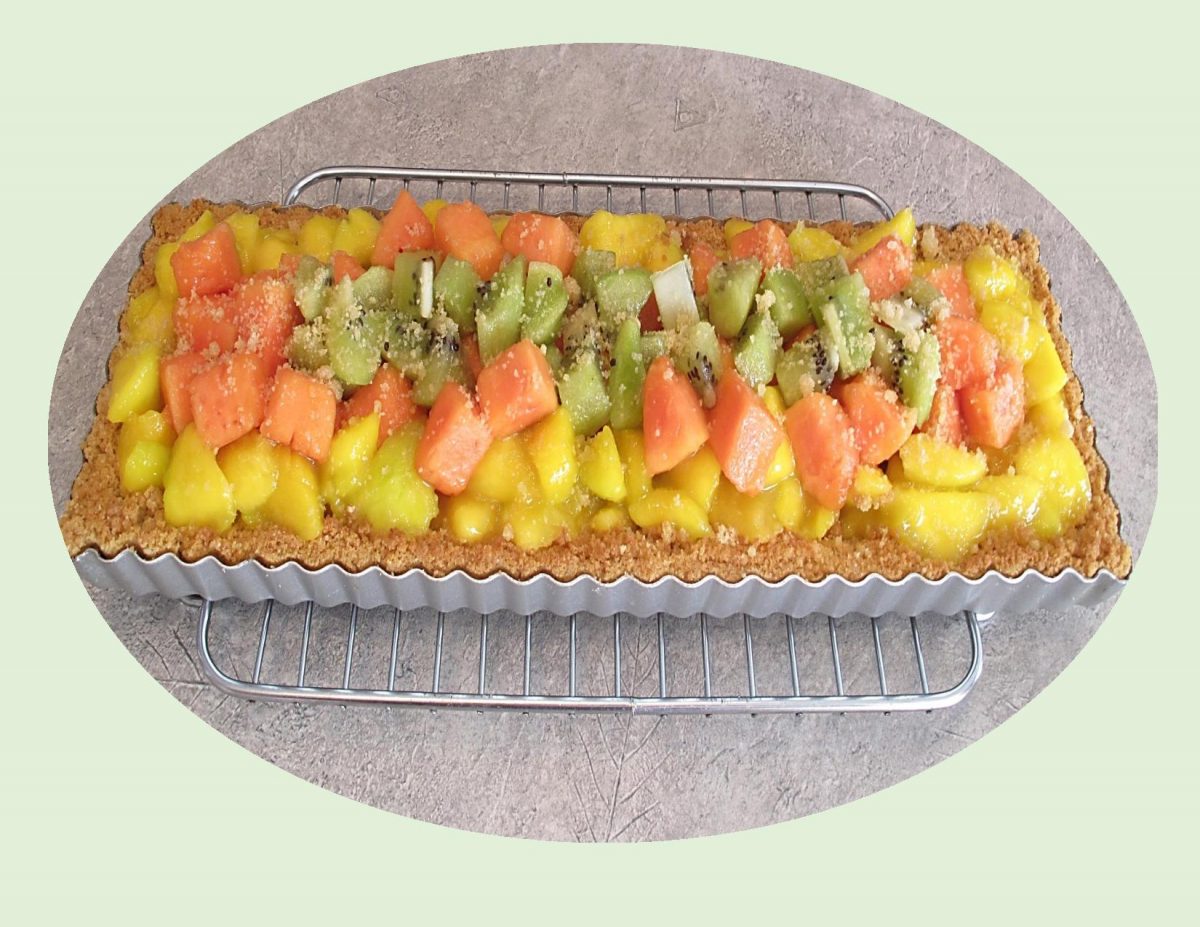
When it comes to pie/tart making, you have two basic types of crust to choose from: pastry or crumb. The decision will ultimately come down to what you’re planning to fill your crust with.
Classic pastry crust consists of a combination of flour, shortening and liquid whereas a crumb crust is comprised of pre-existing food items such as cookies, crackers or nuts, made into crumbs, tossed/coated with melted butter and pressed into a baking dish to form a shell. Both crusts offer unique strengths, which make them especially suited for certain types of pie fillings and utterly incompatible with others.
Pastry pie crust is your best choice for pies or tarts, sweet or savory, that require a relatively long baking time. Pastry of this nature is a labor of love but none the less it gives you the opportunity to create a ‘work of art’.
The major appeal of a crumb crust is, ‘its easy’. There’s no real pastry technique required to make a crumb crust. Its simply a matter of selecting what you want to make your crust from, pulverizing it and combining the crumbs with enough melted butter to make it stick together when you press it into your baking pan.
For this glazed tropical fruit tart, I chose to use some gingersnap cookies for my crust. The colorful fruit makes such a nice presentation as well as a refreshing taste.
Print Recipe
Glazed Tropical Fruit Tart
Votes: 1
Rating: 5
You:
Rate this recipe!
|
|
Votes: 1
Rating: 5
You:
Rate this recipe!
|
Instructions
Crust
-
In a small saucepan, melt butter & stir in sugar. Add crushed gingersnap crumbs; mix well. Spread evenly into a tart pan. Press onto bottom & up the sides to form an even crust. Bake 4-5 minutes or until the edges are lightly browned. Cool on a wire rack before filling.
Filling
In a small saucepan, combine juice & cornstarch; cook & stir until thick & bubbly. Cook & stir for 2 minutes more. Transfer to three bowls. Cover each with plastic wrap & cool for 30 minutes.
Fold each type of fruit (mango, papaya & kiwi) into one of the bowls of fruit juice mixture. Spoon the fruit into the tart shell, arranging it as desired; press the fruit down lightly with a rubber spatula.
Cover with plastic wrap & chill for 3-4 hours. Serve with whipped topping if desired.
Recipe Notes
- I found it necessary to drain off any excess fruit juice that came from the cut fruit before putting it in the juice/cornstarch mixture.

There’s a whole chickpea world out there beyond hummus. From crunchy, spicy snacks to main ingredients in baking and cooking. This is a wonderful ingredient that can adapt extremely well with herbs and spices.
Chickpeas, also known as garbanzo beans, grow in hot parts of the world so they are naturally a key ingredient in the cuisine of countries such as India, Mexico, Egypt and the southern part of Italy. Despite their origins, chickpeas are available everywhere, usually in either canned or dried form. There is very little difference in nutritional value between precooked, canned chickpeas and the dried variety you cook yourself.
In our part of the country, I remember these peas/beans first appearing in the restaurant salad bars. Chickpeas were one of several choices set out in bowls to add to salad greens. Then a few years later they became better known when ‘Mediterranean hummus’ became trendy. Then the notion came up to use them in baking. Legumes in cake? Remember the big debate when ‘someone’ decided to put carrots and zucchini in cakes etc. (not to mention tomato soup).
Chocolate chickpea cake has been a success for quite a while now so I decided to try a different take on the idea of the flourless cake.
Print Recipe
Apple Chickpea Flan w/ Raspberry Sauce
Votes: 1
Rating: 5
You:
Rate this recipe!
|
|
Votes: 1
Rating: 5
You:
Rate this recipe!
|
Instructions
Preheat oven to 350 F. Grease 4 custard baking cups or a 9 X 9-inch square baking pan.
In a food processor, place applesauce, rinsed chickpeas & eggs; blend until almost smooth, scraping down sides as needed. Place in a large bowl.
In another bowl, whisk together remaining ingredients. Add dry ingredients to wet mixture & stir to combine. Pour into baking dishes & bake for about 50 minutes OR until it tests done with an inserted toothpick.
To make raspberry sauce: In a small saucepan, combine cornstarch, sugar & salt. Add water & raspberries; cook until clear & bubbling. Remove from heat & add margarine & lemon juice & zest. Cool & serve over chickpea flan.
Recipe Notes
- In place of one of the eggs I used 1 Tbsp ground flax seed plus 3 Tbsp water.
